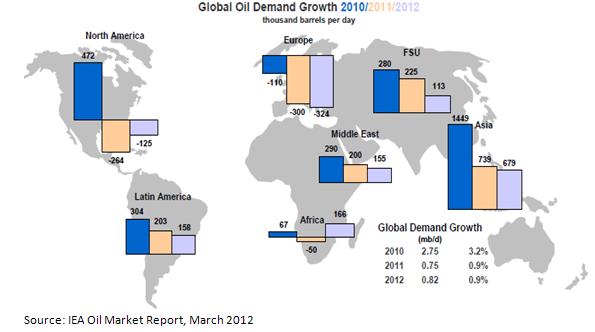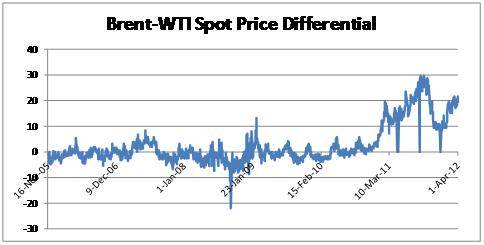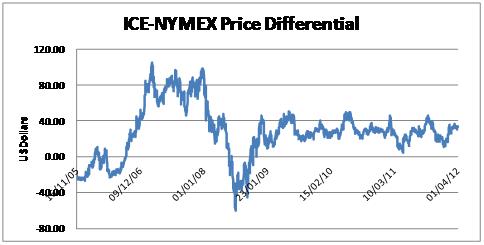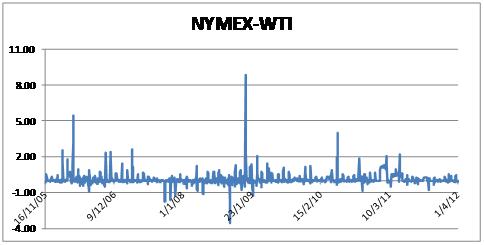Introduction
Where will crude oil prices be in the coming months? In particular will WTI prices breach the USD 130 level as some analysts are predicting or will it fall below the USD 100 level as others forecast? We believe that the price of WTI will probably range between USD 110-115 in the second quarter of 2012.
In this article we examine some factors that we believe have or will have a significant bearing on oil prices and the direction that they will take. We address each factor separately to achieve a greater coherence on the topic. In particular we will be looking at the some of the factors impacting the fundamentals of crude oil, i.e. demand and supply. However, in making an assessment of the overall position or direction that prices will be take, a broader view is recommended.
We begin our analysis with supply first because in recent months it has received a fair amount of discussion in the media and has been given a greater degree of importance as compared to its counterpart (demand) by many analysts.
Supply
The supply of crude oil or rather the constraints to its adequate supply has received a lot of focused attention lately. Most recently the upward trend in crude oil prices has been attributed in part to increasingly restrictive sanctions against Iran by the EU and America which are due to be implemented by July 2012. The situation has been exacerbated by Iran’s own defiant stand for its nuclear program and the possibility of an aggressive response by Israel who want Iran’s nuclear establishments dismantled or destroyed.
Declining imports of Iranian crude products in respective countries and regions including poorer EU countries like Greece who are dependent on Iran for this resource is evidence of how effective these sanctions have been in curtailing supply.
On the other hand, trade sanctions against Iran are not something new. Though the current sanctions are more restrictive, the reality is that Iran has not been a significant contributor to the overall world supply of crude for a number of years due to earlier sanctions imposed on it. Furthermore, Iranian crude is heavy and sour, as opposed to sweet and light, a fact that reduces it importance qualitatively based on the refining capabilities of many EU countries. Though there is a very real threat of an attack by Israel in the 2nd quarter of 2012, the chances of the US being involved in or backing such a conflict is low because it is already stretched militarily between Afghanistan and Iraq.
Supply side issues have also been experienced in non-OPEC crude oil producing countries due to on-going grave civil disputes and conflicts such as those raging between Sudan and South Sudan, and in Nigeria, Syria and Yemen. Total crude oil production for Sudan and South Sunday averaged about 430 thousand barrels per day in 2011 but EIA projects that in 2012 it will only average around 200 thousand barrels per day. EIA also projects Yemen and Syria’s production to be less than half of what it was last year.
Other constraints to crude oil supply in recent months have been weather and mechanical related issues especially for UK and Denmark which continue to hinder the production of North Sea oil. All of these factors tend to exert an upward pressure on the price of Brent.
However not all is bleak on the supply side. With growing diplomatic pressure on Saudi Arabia, the country has increased supply to its highest level in three decades. Saudi Arabia is the only country with swing power, which is the capacity to increase production quickly and significantly, due to its spare excess capacity prowess and inventory levels. OPEC output rose by 315 kb/d to 31.42 mb/d in February 2012 and is expected to continue to increase.
However Saudi Arabia’s crude, like Iran’s, is heavy and sour. A fear among some analysts is that any increase in production of this crude would be restricted by Europe not having sufficient refining capacities for this type of crude.
Another factor assisting supply and thus damping the increase in prices is that Libya is back as a contributor to the crude oil international market after recovering from its civil war. Though quantitatively it is not as important a contender as compared to Saudi Arabia, in terms of crude quality, ‘light’ and ‘sweet’, its oil production is more compatible to the refining capacities in Europe. Based on this EIA had expected non-OPEC output to increase, however due to on-going conflicts in Syria, Yemen etc as mentioned earlier non-OPEC supply declined by 0.5 mb/d.
This drop is not as significant as some would have expected given the sources of supply bottlenecks out there. This is partially due to the fact that world crude oil supply has also been enhanced by increased production from US onshore shale formations, Canadian oil sands and Brazil’s offshore pre-salt oil fields.
In the US crude oil stockpiles have been building up due to infrastructure and pipeline issues which restrict its distribution. This is expected to exert a downward pressure on the price of WTI. If infrastructural issues are resolved for channeling crude oil we would expect this downward pressure to ease.
Also the recent release of strategic oil reserves in France enhanced world supply which was evident in the subsequent decline witnessed in Brent prices. Analysts tend to discount the impact of releasing reserves for longer term price forecasts as they believe that such enhancements only reduce price in the short term and they are no substitute for sustainable market supply.
Demand
IEA estimates the global oil consumption in 2012 will growth by 0.9% over consumption levels in 2011. This is mainly due to weak economic growth which has been further compounded by high oil prices. IMF expects that global economic growth will continue to decelerate to 3.3 % in 2012, down from 3.8 % in 2011 and 5.7 % in 2010.
Europe’s demand is expected to shrink by 2.2% by 0.3 mb/d due to the EU debt crisis. Moreover, anticipated warmer weather in Europe is likely to further reduce demand. In North America too, the demand is expected to decline by 0.5% due to structural declines as well as the fact that the market is not protected by subsidies which means that the higher cost of crude will be passed on the consumer.
The data for OECD countries in January 2012, shows oil product demand falling by 1.4% or 1.7 mb/d on a year-on-year basis and it is expected to fall by 0.9% for the year 2012 as a whole in response to falling levels of economic growth (1.1% projected for 2012, down from 1.6% in 2011) as well as a rationalizing of personal transport preferences including the encouragement of public transport use.
The problem has been heightened in Europe because of the weakening of euro against USD which makes dollar denominated commodities like crude oil more expensive in euro-denominated terms as can be seen in the graph below:
On the other hand, Non-OECD countries supported by stronger economic structures saw a growth in crude oil demand. In addition they have higher income elasticity (responsiveness of demand to unit change in income) for the product where demand for oil is closely related to economic growth. For these countries economic growth is projected to be 5.7% with oil price demand expected to rise by 2.8% to 44.7 mb/d.
Asia is set to dominate 80% of the global oil demand growth in 2012 with China accounting for 45% of the world growth. The rest of the growth is due to the increase in demand for the commodity from resource rich countries where increase in oil prices causes economic growth, like the Middle East and Russia.
China’s demand rose to a seven-month high in January 2012 due to the removal of ban on coal burning at the end of 2011. Its economic growth in 2012 is also targeted at 8.5% for the year and consumption growth is envisioned at 3.9% leading to strong expectation of continuing acceleration in demand for crude oil. Its recently released PMI (Purchasing Managers Index) by the Chinese government is above 50. This means that it is seeing a growing manufacturing industry which is likely to further escalate demand for crude. Some analysts are skeptical however, saying that the index includes a seasonal bias.
International Energy Agency (IEA) estimates 3.2 % growth in Indian oil products demand.
Price Differential and Futures Spread
Brent and WTI are being influenced by differing drivers which has widen the gap between their respective spots prices as can be seen in the price differential graph below:
WTI’s price is subject to downward pressure due to the higher levels of crude oil inventories building up in the US. Brent’s higher price on the other hand is supported by the shortages and production issues in the North Sea and the uncertainty surrounding the situation in Iran and the Middle East.
This trend is expected to continue and even widen in the coming months as can be gauged from the graph below which illustrates the differential between ICE and NYMEX crude oil futures prices. ICE is the EU and world’s Exchange for buying crude oil futures and NYMEX is the exchange for American WTI crude oil futures.
Valuable insights may also be obtained from viewing the spread between the futures contract and the crude spot price.
The graph below shows the spread between NYMEX and WTI:
And the spread between ICE futures and Brent spot price:
There is a marked difference between the two graphs. The futures spread over WTI indicates no significant difference in investors’ expectations from current market rates. On the other hand the ICE-Brent differential shows greater uncertainty and a possible expectation by investors that prices will continue to rise (the average differential in Mar-2012 was around USD 13.7).
In either case note that the current differentials are comparatively lower than what has been witnessed in the past.
Conclusion
EIA forecasts that the price of WTI will on average be USD106 per barrel in 2012 which is USD11 higher than the average price last year.
Based on our analysis of the factors that will likely impact crude oil prices in the coming months we would expect WTI to fall in the range USD 110-115. This will largely be influenced by:
- How investors continue to view the Iran issue and their expectations regarding how it will pan out in the coming months and its subsequent impact on the world supply of crude.
- Any indications as to the recovery and growth in world economies and the impact on the demand for crude.






